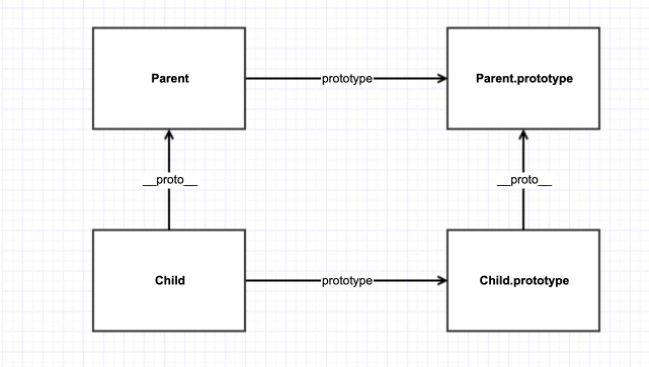由于基本都有了之前的原型链继承等6种集成方法的了解,所以我们直接就上图 方便下面的理解

基本声明
// 匿名类
let Example = class {
constructor(a) {
this.a = a;
}
sayName(){
console.log(this.a)
}
}
// 命名类
let Example = class Example {
constructor(a) {
this.a = a;
}
sayName(){
console.log(this.a)
}
}
class Example {
constructor(a) {
this.a = a;
}
sayName(){
console.log(this.a)
}
}类声明和函数声明的区别和特点:
- 函数声明可以被提升,类声明不能提升(与
let声明类似)- 类声明中的代码自动强行运行在 严格模式 下
- 只能通过
new关键字来声明类,声明类会调用类的构造函数- 每个类都有一个
[[construct]]的方法,该方法就是构造函数- 类的所有方法都定义在类的
prototype属性上- 类中的方法无需添加
function关键字,只需直接添加到类中- 方法间不需要添加逗号(
,),加了会报错- 类中的所有方法都是 不可枚举的(Non-Enumerable),而自定义类型中,可以通过
Object.definedProperty()手工指定不可枚举属性- 在类的实例上调用方法,实质上就是调用原型上的方法
- 不能在类中修改类名
name属性总是返回紧跟class的关键字后的类名this的指向默认指向 类的实例
运行环境的指向
类的方法内部如果含有 this,它默认指向 类的实例。
但是,如果将类方法内部的方法提取出来单独使用,this 会指向该方法 运行时所在的环境,因为找不到相对应的方法而导致报错。
因此,需要 在构造函数中绑定 this ,这样就不会找不到相对应的方法。
class Student {
constructor() {
this.sayName = this.sayName.bind(this);
}
}另一种解决方法是使用 箭头函数。
class Car {
constructor() {
this.sayName = (name = 'BOT') => {
this.sayName(`My name is ${name}`);
};
}
}还有一种解决方法是使用 Proxy ,获取方法的时候,自动绑定 this。
class 属性
prototype
//定义方法
Example.prototype={
//methods
}
//添加方法
Object.assign(Example.prototype,{
//methods
})静态属性
ES6 中规定,Class 内部只有静态方法,没有静态属性。
class Example {
// 新提案
static a = 2;
}
// 目前可行写法
Example.b = 2;公共属性
class Example{}
Example.prototype.a = 2;
实例属性
class Example {
a = 2;
constructor () {
console.log(this.a);
}
}name 属性
返回跟在 class 后的类名(存在时)。
let Example=class Exam {
constructor(a) {
this.a = a;
}
}
console.log(Example.name); // Exam
let Example=class {
constructor(a) {
this.a = a;
}
}
console.log(Example.name); // Example方法
constructor
class Example{
constructor(){
console.log('我是constructor');
}
}
new Example(); // 我是constructor返回对象
class Test {
constructor(){
// 默认返回实例对象 this
}
}
console.log(new Test() instanceof Test); // true
class Example {
constructor(){
// 指定返回对象
return new Test();
}
}
console.log(new Example() instanceof Example); // false静态方法
class Example{
static sum(a, b) {
console.log(a+b);
}
}
Example.sum(1, 2); // 3原型方法
class Example {
sum(a, b) {
console.log(a + b);
}
}
let exam = new Example();
exam.sum(1, 2); // 3实例方法
class Example {
constructor() {
this.sum = (a, b) => {
console.log(a + b);
}
}
}属性表达式
类的属性名,可以采用表达式。
const methodName = 'getArea'
class Square(){
constructor(length){
// ...
}
[methodName](){
// ...
}
}生成器方法
如果某个方法之前加上星号(*),就表示该方法是一个生成器方法(Generator 函数)。
class Foo {
constructor(...args) {
this.args = args;
}
*[Symbol.iterator]() {
for (let arg of this.args) {
yield arg;
}
}
}
for (let x of new Foo('hello', 'world')) {
console.log(x);
}
// hello
// world类的实例化
new
class 的实例化必须通过 new 关键字。
class Example {}
let exam1 = Example();
// Class constructor Example cannot be invoked without 'new'实例化对象
共享原型对象
class Example {
constructor(a, b) {
this.a = a;
this.b = b;
console.log('Example');
}
sum() {
return this.a + this.b;
}
}
let exam1 = new Example(2, 1);
let exam2 = new Example(3, 1);
console.log(exam1._proto_ == exam2._proto_); // true
exam1._proto_.sub = function() {
return this.a - this.b;
}
console.log(exam1.sub()); // 1
console.log(exam2.sub()); // 2decorator(这里的例子照的不好 可以暂时跳过)
decorator 是一个函数,用来修改类的行为,在代码编译时产生作用。
类修饰
一个参数
第一个参数 target,指向类本身。
function testable(target) {
target.isTestable = true;
}
@testable
class Example {}
Example.isTestable; // true多个参数——嵌套实现
function testable(isTestable) {
return function(target) {
target.isTestable=isTestable;
}
}
@testable(true)
class Example {}
Example.isTestable; // true实例属性
上面两个例子添加的是静态属性,若要添加实例属性,在类的 prototype 上操作即可。
function testable(isTestable) {
return function(target) {
target.isTestable=isTestable;
}
}
@testable(true)
class Example {}
Example.isTestable; // true方法修饰
3个参数:target(类的原型对象)、name(修饰的属性名)、descriptor(该属性的描述对象)。
class Example {
@writable
sum(a, b) {
return a + b;
}
}
function writable(target, name, descriptor) {
descriptor.writable = false;
return descriptor; // 必须返回
}修饰器执行顺序
由外向内进入,由内向外执行。
class Example {
@logMethod(1)
@logMethod(2)
sum(a, b){
return a + b;
}
}
function logMethod(id) {
console.log('evaluated logMethod'+id);
return (target, name, desctiptor) => console.log('excuted logMethod '+id);
}
// evaluated logMethod 1
// evaluated logMethod 2
// excuted logMethod 2
// excuted logMethod 1封装与继承
访问父类
通过 Object.getPrototypeOf() 方法可以用来从子类上获取父类。
Object.getPrototypeOf(Child) === Parent;因此,可以通过此方法判断,一个类是否继承了另一个类。
getter / setter
getter 与 setter 必须同级出现, 不可以单独出现
class Example1{
constructor(a, b) {
this.a = a;
this.b = b;
}
get a(){
console.log('getter');
return this._a;//注意这里
}
set a(a){
console.log('setter');
this._a = a;//注意这里 如果用this.a=a 这里会出现自身递归不断被调用 最终导致 RangeError
}
}
let exam1 = new Example1(1,2); // 只输出 setter , 不会调用 getter 方法
console.log(exam1._a); // 1, 可以直接访问extends
通过 extends 实现类的继承。
class Child extends Father { ... }super
子类 constructor 方法中必须有 super ,且必须出现在 this 之前,调用父类构造函数,只能出现在子类的构造函数。
class Father {
constructor() {}
}
class Child extends Father {
//constructor() {}
// or
constructor(a) {
super();//必须在构造函数
this.a = a;
// super(); 这里不能放在后面~~~~
}
}
虽 super 代表了父类 Parent 的 构造函数,但是返回的是子类 Child 的实例,即 super 内部的 this 指的是 Child,因此 super() 在这里相当于:
Parent.prototype.constructor.call(this);当 super 作为对象时:
- 在子类的普通方法
super指向 父类的原型对象Parent.prototype- 通过
super调用父类的方法时,方法内部的this指向当前的 子类实例
- 在子类的静态方法
super指向 父类,而不是父类的原型对象- 通过
super调用父类的方法时,方法内部的this指向当前 子类,而不是子类的实例
class Father {
test(){
return 0;
}
static test1(){
return 1;
}
}
class Child2 extends Father {
constructor(){
super();
// 调用父类普通方法
console.log(super.test()); // 0
}
static test3(){
// 调用父类静态方法
return super.test1+2;
}
}
Child2.test3(); // 3这里更多细节就不写了 因为我觉得基本够了 这里有部分参考资料来源这里。

